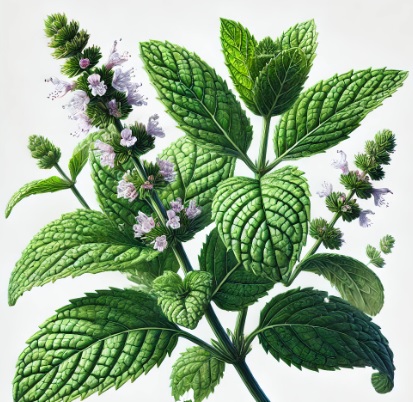Mentha spicata, commonly known as Spearmint, is a plant in the Labiatae (Lamiaceae) family. It is valued for its aromatic leaves and stems, which are used for various culinary, medicinal, and cosmetic ...
Mentha spicata, commonly known as Spearmint, is a plant in the Labiatae (Lamiaceae) family. It is valued for its aromatic leaves and stems, which are used for various culinary, medicinal, and cosmetic applications. The plant is characterized by its fresh, minty fragrance and is commonly cultivated for its essential oil and extract.
Chemical Composition and Structure:
Carvone: The primary compound responsible for the characteristic spearmint aroma.
Limonene: Provides citrusy notes to the fragrance profile.
Piperitone: Adds a minty and slightly sweet scent.
Other Terpenes: Includes additional terpenes that contribute to the plant's aromatic and therapeutic properties.
Physical Properties:
Appearance: The plant has square stems and opposite, ovate to lanceolate leaves with a bright green color. The flowers are small, typically purple or white, and arranged in dense spikes.
Odor: Fresh and minty aroma, primarily due to the presence of carvone and other aromatic compounds.
Solubility: The plant itself is not soluble in water, but its extracts and essential oils can be.
pH: The plant’s pH is generally neutral to slightly acidic.
Production Process:
Cultivation: Mentha spicata is grown in well-drained soil with adequate sunlight and water. It is cultivated globally and is especially common in temperate climates.
Harvesting: The plant is harvested when it reaches peak aromatic quality, typically during the flowering stage.
Processing: The leaves and stems can be used fresh or dried, and are often processed into essential oils or extracts.
Formulation: The plant material is used in various formulations for its aromatic and therapeutic properties, including culinary dishes, teas, and cosmetic products.
Applications:
Culinary Uses: Widely used as a flavoring in cooking and beverages.
Medicinal Uses: Utilized in traditional medicine for its potential digestive, anti-inflammatory, and soothing properties.
Cosmetics and Skincare: Incorporated into products for its refreshing and invigorating qualities, as well as its minty fragrance.
Aromatherapy: Employed in diffusers and other products for its pleasant, minty aroma and potential therapeutic benefits.
Environmental and Safety Considerations:
Environmental Impact: Cultivation should be managed sustainably to reduce environmental impact and maintain soil health.
Safety: Generally considered safe for most uses. As with all plant-based products, individual sensitivities or allergies should be considered, and proper usage guidelines should be followed.
INCI:
Perfuming. Unlike fragrance, which can also contain slightly less pleasant or characteristic odours, the term perfume indicates only very pleasant fragrances. Used for perfumes and aromatic raw materials.
Synonyms:
CAS:
![]() Mentha spicata
Mentha spicata 

